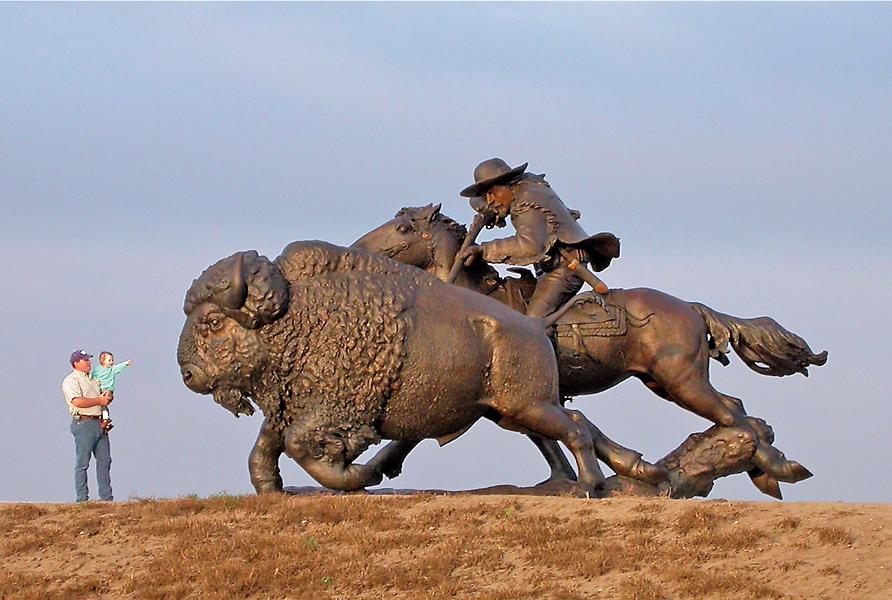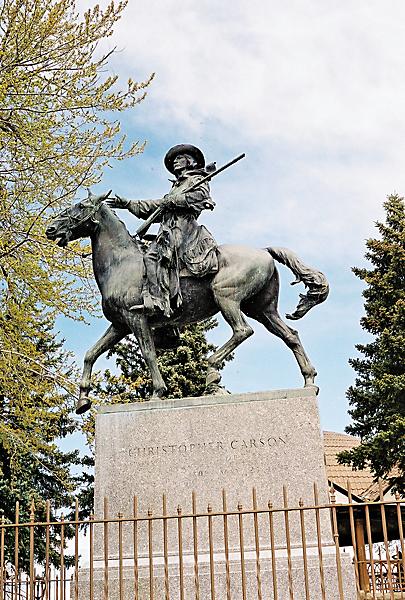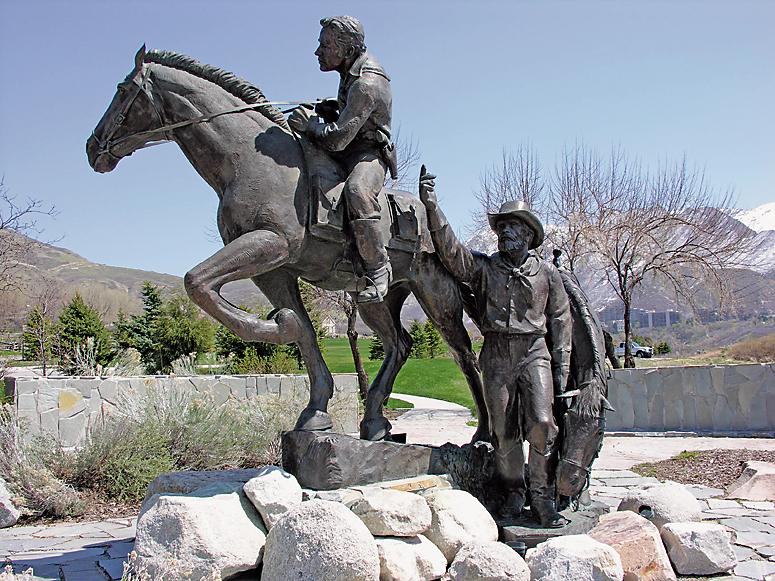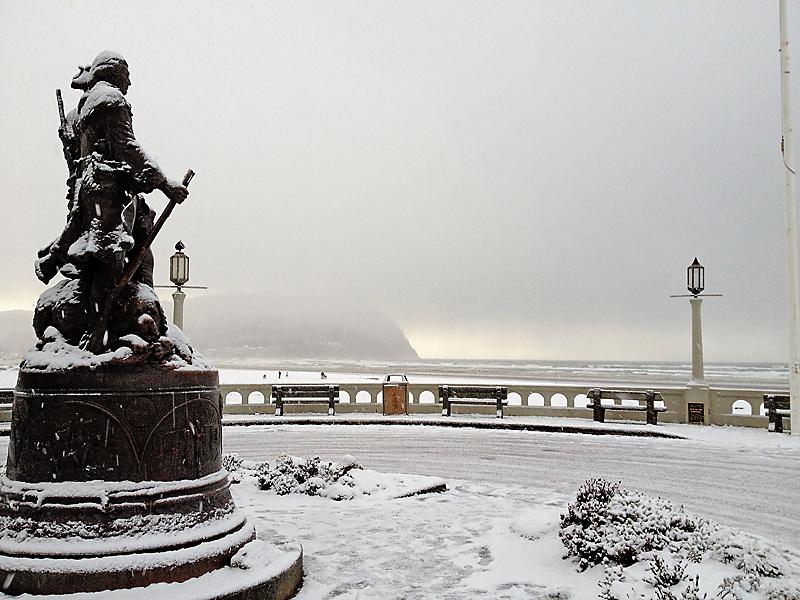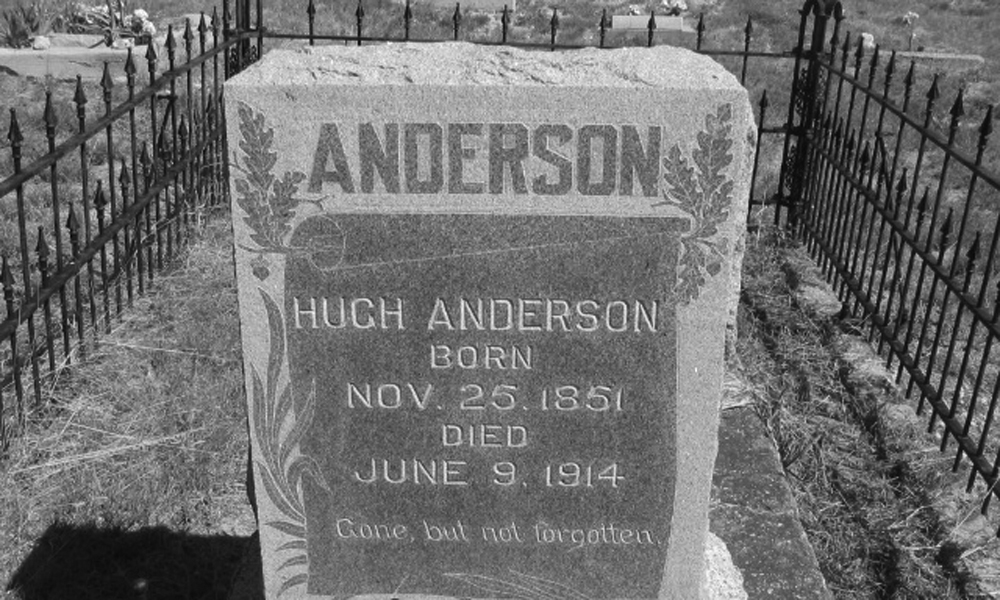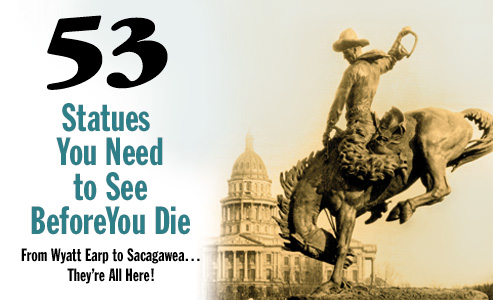 Nearly half a century after Denver denizens commissioned Preston Powers to create Closing of an Era, the city put its faith in a prominent sculptor who, at the age of 11, had moved to Denver with his family in 1871. In 1917, Alexander Phimister Proctor showed Denver Mayor Robert Speer a model of the Bronco Buster he had been working on after attending Oregon’s Pendleton Round-Up three years earlier.
Nearly half a century after Denver denizens commissioned Preston Powers to create Closing of an Era, the city put its faith in a prominent sculptor who, at the age of 11, had moved to Denver with his family in 1871. In 1917, Alexander Phimister Proctor showed Denver Mayor Robert Speer a model of the Bronco Buster he had been working on after attending Oregon’s Pendleton Round-Up three years earlier.
By 1920, the finished Proctor bronze was dedicated.
Yet what most probably don’t know when they look at this bronze in Civic Center Park is that Proctor had to bail out his model, Bill “Slim” Ridings, who had been arrested for cattle rustling. The artist couldn’t finish the sculpture without the Pendleton rodeo competitor.
With True West recognizing the Denver Art Museum as this year’s top Western art museum in the nation, Denver and these two larger-than-life sculptures seem a fitting start to our selection of historical sculptures all Old West enthusiasts should see before they die.
—The Editors
Photo Gallery
Artist: Wes Chapman
Year: 1988
Where: Phoenix, Arizona
Why You Need to See it: Commemorate Arizona’s centennial by paying homage to the peace officers killed in the line of duty since 1863, the year Arizona became a territory. (Plus, we think the statue has a striking likeness to Wyatt Earp!)
– By Beatrice Ray –
Artist: Dave McGary
Year: 2005
Where: Laramie, Wyoming
Why You Need to See it:Portrays the moment when Shoshoni Chief Washakie raises his lance to challenge Crow Chief Big Robber to begin the 1866 duel at Crowheart Butte; when he won, the victorious Washakie displayed the cut-out heart of his enemy at the end of his lance.
– Courtesy Dave McGary –
Artist: Charlie Norton
Year: 2004
Where: Oakley, Kansas
Why You Need to See it: Norton’s statue is located at the site of the alleged hunting competition between Buffalo Bill Cody and Army scout Bill Comstock. Besides, it’s huge!
– Courtesy Oakley Area Tourism –
Artist: Alexander Phimister Proctor
Year: 1920
Where: Denver, Colorado
Why You Need to See it:
It’s just fun to think of the artist struggling to bring the reality of the Pendleton Round-Up to life, not because of artistic issues, but because his cowboy model was in jail for cattle rustling.
– Courtesy Denver Art Museum –
Artist: Frederic Remington
Year: 2005
Where: Clovis, California
Why You Need to See it: This city shows its love for its local rodeo, held since 1914, with a recast of Remington’s most famous bronze.
– Courtesy Clovis Visitors Center –
Artist: Gertrude Vanderbilt Whitney
Year: 1924
Where: Cody, Wyoming
Why You Need to See it: This tribute to Buffalo Bill Cody was, in our view, the definitive work of the New Yorker heiress and artist.
– Courtesy Buffalo Bill Historical Center –
Artist: Eddie Dixon
Year: 1992
Where: Fort Leavenworth, Kansas
Why You Need to See it:Honors the black soldiers of the 9th and 10th Cavalry Regiments who were stationed nearby during the Indian Wars.
– True West Archives –
Artist: Ulysses Grant Speed
Year: 1980
Where: Canyon, Texas
Why You Need to See it: The legendary Texas Panhandle cattleman was a giant in our world. You have to pay homage to him.
– Courtesy Panhandle-Plains Historical Museum –
Artist: Frederic Remington
Year: 1981
Where: Oklahoma City, Oklahoma
Why You Need to See it: Brilliantly portrays mounted cowboys in a flurry of action, firing their pistols into the air.
– Courtesy National Cowboy & Western Heritage Museum –
Artist: Eugene L. Daub
Year: 2000
Where: Kansas City, Missouri
Why You Need to See it: This places Sacagawea in her proper context, alongside the legendary explorers Lewis & Clark and their black slave York, who fascinated many of the Indians they came across in their journey.
– Courtesy Kansas City Convention & Visitors Association –
Artist: Franz Johansen
Year: 1998
Where: Florence, Nebraska
Why You Need to See it: With their feet barely touching the ground, this family of handcart pioneers speaks of the anticipation and faith of the pioneers who trekked west to Zion in the Rocky Mountains.
– Courtesy Mormon Trail Visitor’s Center –
Artist: Harold T. Holden
Year: 2000
Where: Oklahoma City, Oklahoma
Why You Need to See it: Depicts a typical scene when ranchers and cowboys would herd their cattle to the stockyards, which helped to develop this area into the “world’s largest stocker and feeder cattle market.”
– Courtesy Stockyards City –
Artist: Jason Scull
Year: 2001
Where: San Marcos, Texas
Why You Need to See it: The artist’s first life-sized sculpture commemorates the 1840s Texas Rangers captain for whom Hays County is named.
– Courtesy San Marcos CVB –
Artist: David Manuel
Year: 1981
Where: Winterset, Iowa
Why You Need to See it: The Western film icon’s legendary demeanor is captured in bronze near the very home where he was born.
– Courtesy John Wayne Birthplace –
Artist: Buckeye Blake
Year: 1986
Where: Great Falls, Montana
Why You Need to See it: Because after Charlie Russell’s years working on a sheep ranch and living like a cowboy, he moved here, to Great Falls, to focus on his art and ultimately gained worldwide fame as the Cowboy Artist.
– Courtesy Central Montana’s Russell Country –
Another view.
Artists: Sonny Rivera & Betty Sabo
Year: 2006
Where: Albuquerque, New Mexico
Why You Need to See it: These sculptures of Don Juan de Oñate leading a caravan of settlers into the territory acknowledge the city’s Spanish Colonial roots.
– Courtesy City of Albuquerque Public Art –
Artist: James Muir (shown)
Year: 2008
Where: Reserve, New Mexico
Why You Need to See it: This is a testament to the courage of man; Elfego Baca stood up against an alleged 80 cowboys in a single-handed gunfight, surviving roughly thousands of bullets sent his way.
– Courtesy James Muir –
Artist: Herb Mignery
Year: 2008
Where:Scottsdale, Arizona
Why You Need to See it: The Pony Express tradition was revived by Arizona’s Hash Knife Pony Express, a group that, ever since 1958, annually delivers more than 20,000 letters on a 200-mile relay from Holbrook to Scottsdale.
– Courtesy Scottsdale Public Art –
Artist: Dr. Avard T. Fairbanks
Year: 2001
Where: Casper, Wyoming
Why You Need to See it: …along the way, see a rider about to disembark in mid-journey…
– Courtesy NPS / Chuck Milliken –
Artist: Hermon A. MacNeil
Year: 1940
Where: St. Joseph, Missouri
Why You Need to See it: Follow the route of these short-lived 1860-61 mail carriers by taking a photo of yourself at this fitting tribute and then…
– Courtesy St. Joseph Visitors Bureau –
Artist: Thomas Holland
Year: 1960
Where: Sacramento, California
Why You Need to See it: …and document the experience in the city where the first rider arrived 10 days later (on April 13, 1860).
– Courtesy Sacramento CVB –
Artist: Jack Bryant
Year: 1992
Where: Fort Worth, Texas
Why You Need to See it: Pays tribute to the Comanche chief whose first visit to the city in 1885 almost killed him; across the street is the Cowtown Coliseum at the Stockyards where he performed at the 1909 rodeo.
– True West Archives –
Artist: Solon Borglum
Year: 1907
Where: Prescott, Arizona
Why You Need to See it: Buckey O’Neill is a hometown hero who knew the Earps at the time of the 1881 O.K. Corral gunfight and would die in action during the Spanish-American War in Cuba in 1898. His Rough Riders commander, Teddy Roosevelt, famously recalled how O’Neill said to another soldier, “Sergeant, the Spanish bullet isn’t made that will kill me.”
– Courtesy Arizona Office of Tourism –
1907 Dedication: Note the lack of trees.
Artist: Agnes Vincen Talbot
Year: 2003
Where: Salmon, Idaho
Artist: Alice Cooper
Year: 1906
Where: Portland, Oregon (inset)
Why You Need to See Them: Sacagawea acted as a symbol of peace and as interpreter during Lewis & Clark’s expedition, while carrying her newborn son Pomp on her back.
– Above: Courtesy Sacajawea Center; Left: Courtesy Washington Park –
Artist: Heather Soderberg
Year: 2011
Where: Cascade Locks, Oregon
Why You Need to See it: We just love the patination of the golden yellows, deep blues and rustic reds that celebrate the spirit of the Shoshoni guide’s life as an interpreter for Lewis & Clark.
– Courtesy Port of Cascade Locks –
Artist: John Massey Rhind
Year: 1906
Where: Hartford, Connecticut
Why You Need to See it: These two sculptures tell the story of how Colt’s sailor life as a young man inspired him to create the gun that won the West, the Peacemaker, and other firearms that shaped the lives of so many living on the American frontier.
– Courtesy Hartford Business Improvement District –
Artist: Robert Temple Summers
Year: 2012
Where: Roswell, New Mexico
Why You Need to See it: Summers is pretty much one of today’s top sculptors when it comes to portraying the Old West, and his latest is this tribute to the lawman who killed Billy the Kid.
– True West Archives –
Artist: Edward Clark Potter
Year: 1992
Where: Monroe, Michigan
Why You Need to See it: Custer buff Paul Andrew Hutton says this is the BEST statue of George Armstrong Custer out there.
– True West Archives –
Artist: Fred Hoppe
Year: 2001
Where: Grand Forks, North Dakota
Why You Need to See it: Honors the Sioux leader who was born and raised near the Standing Rock reservation in Dakota Territory and grew up to lead a resistance movement against the government.
– Courtesy Ralph Engelstad Arena –
Artist: Tim Trask
Year: 2008
Where: Tombstone, Arizona
Why You Need to See it: Like Arizona State Historian Marshall Trimble (shown) would tell you, who could visit Tombstone without seeing a tribute to its famous lawman, Wyatt Earp?
– Courtesy Marshall Trimble –
Artist: Peggy Detmers
Year: 2003
Where: Deadwood, South Dakota
Why You Need to See it: Shares the story of the great bison hunt, with 14 bison fleeing three ready-to-attack Northern Plains Indians on horseback, with some bison even leaping off cliffs to their deaths.
– Courtesy Peggy Detmers –
Artist: Pompeo Coppini
Year: 1907
Where: Austin, Texas
Why You Need to See it: It was erected by surviving comrades who fought under Col. Benjamin Franklin Terry after his Rangers were mustered in Houston in 1861.
– Courtesy Texas Legislature –
Artist: Joe Beeler
Year: 1988
Where: Wickenburg, Arizona
Why You Need to See it: This grateful cowboy kneeling in front of his horse touches pretty much everyone who sees the bronze.
– Courtesy Desert Caballeros Western Museum –</i?
Artist: Harry Weber
Year: 2006
Where: St. Louis, Missouri
Why You Need to See it: The Mississippi River sometimes floods to the point where you barely see this Lewis & Clark statue, if at all; so you better catch a sighting of it whenever you can!
– True West Archives –
Artist:Preston Powers
Year: 1893
Where: Denver, Colorado
Why You Need to See it: Some of Denver’s citizens weren’t happy with this bronze (they wanted it to look more like Chief Ouray, who had walked their streets 20 years before), but even so, this is still a remarkable first tribute to Western heritage by a remarkable frontier town.
– Courtesy Denver Art Museum –
Artist: James Muir
Year: 2010
Where: Sheridan, Wyoming
Why You Need to See it: We love this joyful bronze because it inspires many a couple to dance alongside the happy pioneer cowboy and his wife.
– Courtesy James Muir –
Artist: Harold T. Holden
Year: 2007
Where: Enid, Oklahoma
Why You Need to See it: Honors those who took part in the late 1800s Cherokee Strip land rush for the opportunity to start a new life.
– Courtesy Cherokee Strip Regional Heritage Center –
Artist: Buck McCain
Year: 2003
Where: Orange, Texas
Why You Need to See it: This Plains Indian’s act of holding up a buffalo skull to the sky represents a call to a higher power, that union between the physical and spiritual that many of us seek to help us soar in our daily lives.
– Courtesy Stark Museum of Art –
Artist: Robert Temple Summers
Year: 2009
Where: Artesia, New Mexico
Why You Need to See it: Renowned Billy the Kid historian Frederick Nolan thinks it has an uncanny likeness to the outlaw.
– All courtesy Artesia Main Street –
Artist: Vic Payne
Year: 2007
Where: Artesia, New Mexico
Why You Need to See it: …the trail boss goes after him.
Artist: Mike Hamby
Year: 2008
Where: Artesia, New Mexico
<p<Why You Need to See it: He notices the rustler attempt to rebrand one of the steers and…
Artist: Frederic Remington
Year: 1908
Where: Philadelphia, Pennsylvania
Why You Need to See it: Remington himself picked out the location for this public art, his only one erected during his lifetime.
– Courtesy Fairmount Park –
Artist: Shiela Cavalluzzi
Year: 2011
Where: Burbank, California
Why You Need to See it: The lone railway worker walks on portions of the original Southern Pacific Railroad track that led to the city’s development.
– Courtesy City of Burbank Chandler Bikeway –
Artist: Stanley Wanlass
Year: 1990
Where: Seaside, Oregon
Why You Need to See it: Designed as the official end of the 18-month Lewis & Clark journey (the explorers stopped about half a mile south of here), this bronze faces the gorgeous Oregon Coast.
– Courtesy Seaside Visitors Bureau –
Artist: Tomas Bustos & David Newton
Year: 2012
Where: Fort Worth, Texas
Why You Need to See it:This model of the final statue erected just this year pays tribute to the Mexican cowman’s contribution to the cattle industry and to Fort Worth.
– Courtesy Fort Worth Art Commission –
Artist: Erik Christianson
Year: 2012
Where: Boerne, Texas
Why You Need to See it: Be among the first to see the final creation when the sculpture unveils this November!
– Courtesy Erik Christianson –
Artists: Bryan Haynes, Jane McNeely & Mark Aeling
Year: 2006
Where: Kansas City, Kansas
Why You Need to See it: Even Kansas City pays tribute to the lawman’s stints in Wichita and Dodge City.
– Courtesy Legends at Village West –
Artist: Mary Spurgeon
Year: 2004
Where: Dodge City, Kansas
Why You Need to See it: Wyatt Earp served as the town’s assistant marshal, and he appears to still be protecting and greeting its citizens, albeit in bronze.
– Courtesy Dodge City Trail of Fame –
Artist: Dan Bates
Year: 2005
Where: Tucson, Arizona
Why You Need to See it: The historic Tucson Depot was the site of the 1882 incident involving Wyatt Earp & Doc Holliday that left the outlaw cowboy Frank Stilwell dead.
– Courtesy Tucson CVB / Jessica Stephens –





